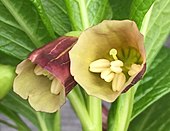Scopolia
| Scopolia | |
|---|---|

| |
| Scopolia carniolica | |
| Scientific classification | |
| Kingdom: | Plantae |
| Clade: | Tracheophytes |
| Clade: | Angiosperms |
| Clade: | Eudicots |
| Clade: | Asterids |
| Order: | Solanales |
| Family: | Solanaceae |
| Subfamily: | Solanoideae |
| Tribe: | Hyoscyameae |
| Genus: | Scopolia Lam. |
| Species | |
Scopolia is a genus of four species of flowering plants in the family Solanaceae, native to Europe and Asia. The genus is named after Giovanni Scopoli (1723–88), a Tyrolean naturalist. The genus has a disjunct distribution, with two recognised species in Central to Eastern Europe, (including the Caucasus), and two species in East Asia. The two European species are:
- Scopolia carniolica Jacq. of Slovenia, Austria and the Carpathian Mountains
- ex Kreyer of the Caucasus
and the two Asiatic species are:
- of Korea
- Scopolia japonica Maxim. of Japan
The four species in the equally medicinal genus Anisodus
- Anisodus tanguticus (Maxim.) Pascher
- Link ex Spreng.
- (C.Y.Wu & C.Chen) D'Arcy & Z.Y.Zhang
- C.Y.Wu & C.Chen
have in the past been placed in the genus Scopolia, as has the monotypic genus Atropanthe with its single species Pascher.[1]
Scopolia carniolica - the longest-known species and the one with the westernmost distribution - is a creeping perennial plant, with light green leaves and dull reddish-purple flowers (cream in the attractive and more ornamental variety hladnikiana, sometimes cultivated as a decorative plant). Scopolia's extract (which contains a form of the alkaloid scopolamine) is used in at least one commercial stomach remedy (, produced by Sato Pharmaceutical). The extract is an anti-spasmodic in low doses and may be used to relax smooth muscle tissue or prevent motion-sickness induced nausea; in higher doses it is a poison having hallucinogenic and memory-inhibiting effects.
Other alkaloids found in Scopolia carniolica include cuscohygrine, hyoscyamine and .
The coumarin phenylpropanoids umbelliferone and scopoletin have been isolated from the roots of Scopolia japonica.
Comparison of Scopolia carniolica with Atropa belladonna[]






The existence of the synonym Scopolia atropoides (i.e. "Atropa-like Scopolia") for Scopolia carniolica demonstrates the perceived similarity between Scopolia carniolica and its better-known relative Deadly Nightshade (Atropa belladonna). The most obvious dissimilarity lies in the respective fruits, that of Scopolia being a pyxidium (i.e. a dry, pot-like capsule with an operculum (lid)) while that of Atropa is a juicy, glistening, jet-black berry bearing a superficial resemblance to a cherry - indeed this pyxidium / berry dichotomy constitutes the feature separating the genus Atropa into a subtribe of its own within the Solanaceous tribe Hyoscyameae: all other genera in tribe Hyoscyameae have the same type of dry, pyxidial capsule as Scopolia. Other points of dissimilarity include:
- Pedicel type: Scopolia carniolica, long, slender and delicate / Atropa belladonna, shorter and broadening toward the calyx - particularly at fruiting.
- Calyx type: Scopolia carniolica, cup-shaped, with slight peaks rather than distinct lobes / Atropa belladonna distinctly lobed, the individual lobes somewhat leaf-like and these lobes spreading to make the calyx star-shaped in fruit.
- Colour of corolla: Scopolia carniolica, exterior: purplish-brown striped longitudinally with cream veins, interior: cream, except for some dark venation at the very base / Atropa belladonna, dull purple shading to green netted with darker veins at the base.
- Glabrescence / pubescence: Scopolia carniolica, glabrous (hairless), the corolla often having a glossy, "enameled" appearance / Atropa belladonna pubescent (hairy), the corolla and calyx being clothed in short trichomes (hairs) - though less so in those of its eastern subspecies A. belladonna ssp. caucasica.
- Corolla shape: Scopolia carniolica, simple, un-lobed, straight-sided bell / Atropa belladonna urceolate (= urn-shaped) bell bearing short but distinct lobes, somewhat recurved.
- Pistil: Scopolia carniolica, straight and shorter than corolla / Atropa belladonna, curved and exserted (=protruding beyond corolla).
Gallery[]

Scopolia japonica (Common name in Japanese: 走りどころ Hashiri-dokoro), plant in flower, Korea.

Scopoliae Rhizoma (root of Scopolia japonica)
References[]
Further reading[]
- Ben-Wyk, Erik; Wink, Michael (2004). Medicinal Plants of the World. Timber Press. ISBN 0-88192-602-7.
- Huang, Kee Chang; Williams, Walter (1999). The pharmacology of Chinese herbs. CRC Press. ISBN 0-8493-1665-0.
- D'Arcy, William G. (1986). Solanaceae. Columbia University Press. ISBN 0-231-05780-6.
- Solanoideae
- Solanaceae genera
- Solanales stubs


